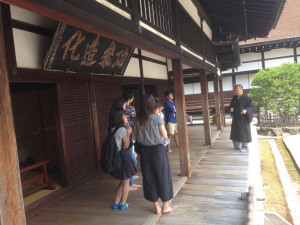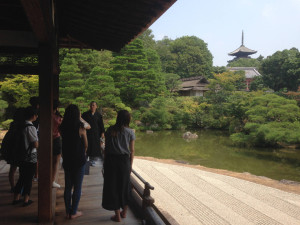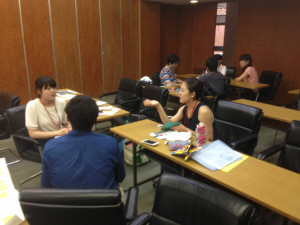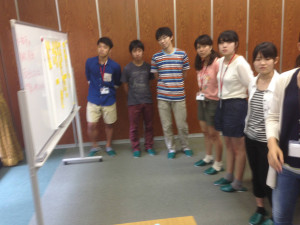Here, we will report on the class and student activities of the Ninnaji x Ritsumeikan University “Special Practicum for Policy Science 1: Ninnaji, a World Heritage Site in Kyoto” (instructor: Masanari Sakurai).
Ninna-ji Temple Visit/Survey Plan
On August 4th (Monday), a full-fledged class by Professor Sakurai of Ritsumeikan University, who develops activities at Ninna-ji Temple, started in the precincts of Ninna-ji Temple.
The theme of Professor Sakurai’s class is to use Asset-Based Community Development (ABCD), a method of regional revitalization, to increase the appeal and value of Ninna-ji both globally and locally. , to explore the possibility of implementing a project that can create new “relationships”.”ABCD” means revitalizing and developing the region based on the resources that exist in the region. In order to revitalize and develop everything, not only the cultural assets, nature and scenery that exist in the area, but also the schools, hospitals, and companies that exist in the area, as well as the diverse local residents and the connections between them. In class, students will understand
the strengths of Ninnaji Temple, which has a history of more than 1,100 years, and also learn about the local community such as schools, accommodation facilities, shops, and transportation facilities that exist in the surrounding area. By understanding the resources, we will come up with new project proposals.Furthermore, we aim to realize experimental initiatives based on those ideas.Meet at Ninnaji Temple at 10:00 am on the first day of class
. After a self-introduction and an explanation of the class outline and schedule by Professor Sakurai, the students toured the precincts under the guidance of Yoshimasa Kanazaki, a priest of Ninnaji Temple and manager of the property management section of the finance department.
Mr. Kanazaki introduced the buildings and cultural assets on the precincts of Ninna-ji Temple, as well as the ingenuity and difficulties involved in maintaining the cultural assets, and provided topics from various perspectives on Ninna-ji Temple . It was very hot that day, but Mr. Kanazaki gave us a detailed explanation, and the students listened intently to the information.


In the afternoon, after receiving a lecture on the “ABCD approach” by Mr. Sakurai, based on the morning tour and topics provided by Ninna-ji Temple, we used imitation paper and post-its about the “attractiveness, resources, and interesting points of Ninna-ji Temple.” I held a workshop using The work progressed in a lively atmosphere, and the students offered many opinions on cultural value, nature, land, related facilities, and local residents. In addition, for the developmental survey to be conducted in the next class, discuss what to survey, and as a result, divide into a team to survey tourists and a team to survey surrounding facilities and areas. have become. Each team made their next survey plan, and this class ended.


Next time, we will hold a training camp class at Ninna-ji Temple on September 17th and 18th, and on the following day, September 19th, we plan to wrap up the training camp and conduct a tourist survey in front of JR Kyoto Station.















